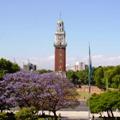
A (very brief) Guide to Buenos Aires
Buenos Aires, the capital and largest city of Argentina, is one of the most mesmerizing cities in the Americas. Plenty of magnificent buildings and monuments recall the city’s heyday in the 19th and early 20th century when Europeans emigrated to this prosperous metropolis.
Despite its European connections, Buenos Aires has a flavor all its own. Street performers doing the tango are as much a part of the landscape as famous buildings like the opulent, French-designed Teatro Colon. Local culture is celebrated in the weekly Mataderos Fair, featuring regional food, crafts and horse races. The city’s dozens of neighborhoods, each with its own personality, offer museums, restaurants, shopping, history, dancing and outdoor activities to suit any taste or budget.
Predominant Architecture:
Buenos Aires architecture is characterized by its eclectic nature, with elements resembling Barcelona, Paris and Madrid. There is a mix, due to immigration, of Colonial, Art Deco, Art Nouveau, Neo-Gothic and French Bourbon styles. Italian and French influences increased after the declaration of independence at the beginning of the 19th century, though the academic style persisted until the first decades of the 20th century.
More recent architecture can be found as well, in particular in the gentrified Puerto Madero district where modern skyscrapers tower over the old docks.
Places to see:
Recoleta Cemetery: Many presidents and historic figures important to Buenos Aires history are buried there. The architecture styles of the tombs range from neo classic to art deco and the some of the sculptures have declared national historic monuments.
San Telmo: Buenos Aires has tons of really different neighborhoods, but none of them embodies the traditional culture like the bohemian San Telmo.
Puerto Madero: By day, this riverfront area is a booming business and shopping district and by night, a hip neighborhood with pricey restaurants and fashionable clubs.
Casa Rosada: The government’s executive branch is housed in this building, a strange mix of various architectural styles, perhaps best known for the balcony from which Evita rallied the working class crowds.
Caminito: Colorful and traditional, this walkway in the La Boca area is dominated by tango dancers and artisans.